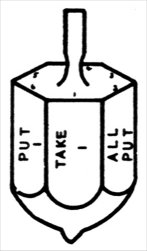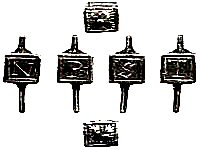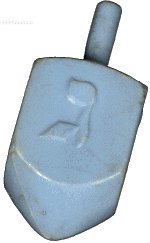"Dreidel" or "Put & Take" are similar traditional after-dinner tablegames played by some Jewish families around the world during the eight day Hanukkah Festival each year. While the game is now used to commemorate a happening in Jerusalem in the year 165 BC, the game probably evolved in Germany only within the last few hundred years. This page examines the development of the game and how it is played.

According to the Oxford English Dictionary, the origin of the game of "Dreidel" is the "Teetotum" (drawing at the left), a gambling top that was known in ancient Greece and the Hashemonean kingdom. David Parlett, The Oxford History of Board Games, 1999, pages 29-30, states that the Teetotum was originally a cubic die threaded on a spindle so that only one of its sides where capable of showing after it was spun. He indicated that it was used for a popular 16th century German gambling game. Brueghel's painting of 1560, Kinderspiel, illustrates a Teetotum from this period. (To see the Brueghel's illustration from his painting, and to read how the game was played, click the Brueghel item in the left menu pane.) While originally a threaded cubic die, later the Teetotum became a six sided polygon and each of it's sides featured one of the faces of a cubic die.
While earlier it was used for gambling purposes, the Teetotum evolved during Victorian times in England and North America, and was used as a chance device to replace dice in boxed boardgames because of clerical admonitions regarding the use of dice. R.C. Bell, Board and Table Games from Many Civilizations, NY: Dover Publications, 1979, Volume 2, pages 6-10, discusses two such games 1) Jubilee (1810), and 2) Eccentric Excursion To The Chinese Empire (1843). Bell and Parlett both include information about a Victorian gambling game known as "Put and Take" which used a Teetotum.

This game uses a six-sided Teetotum shaped like a top. Rather than dice pips on it's sides, it indicated player actions.
According to Bell (Volume I, page 148), each player puts an equal number of counters into a pool and then the opening player spins the six-sided teetotum and follows the instructions on the face uppermost:
1. Take one
2. All Put
3. Take All
4. Put two
5. Take two
6. Put one
Parlett (page 29-30) indicates that a Latin device with a cubic threaded die on a spindle was called a totum, and included the letters P-N-J-F or A-R-J-F, one letter on each face of the cube. He points out that the letters on the cube had the following meanings:
P (French piller, "plunder") or A (Latin accipe, "receive") - retrieve the pool stake;
N (Spanish nada, "nothing") or R (French rien "nothing") - player gets nothing;
J (Middle French jocque, "game") - the player doubles the pool stake;
F (French fors, "out") - player takes all in the pool.
Parlett states that:
Its English counterpart appears in the early 18th century, "as a square piece of board with a spindle through the centre, allowing it to be spun like a top. Three sides were blank and one marked with a 'T' - whence its name, originally written 'T-totum'... by the end of the century six-side teetotums were regularly included in family board games in place of dice... to protect the family atmosphere from the taint of the gaming table or gambling den.

A viewer of this Website was metal detecting in the north of England. The photo on the right illustrates his find. The device appears to be made of silver, and it is not known when or where it was made.
Note that in this device, the letters "N", "P", "S", "T" are embossed. Physically, the device is somewhat different from a typical English "Put & Take" device - appearing to resemble a "Dreidel" (see below). However, unlike a "Dreidel", this device has English letters, perhaps representative of the English words:
Nothing - the player gets nothing from the pot
Put - the player puts an agreed upon stake in the pot
Some - the player takes an agreed upon stake from the pot
Take - the player takes the entire pot

In Germany in the 16th century, under the name "Kreisel" (to spin), the Dreidel evolved as a device to be used during the Hanukkah Festival - the Jewish festival commemorating the event that happened in Jerusalem in the year 165 BC.
Pictured to the left is a modern plastic Dreidel, although ones made of wood, silver, ivory, and other materials exist throughout the world. Stamped onto the sides of the Dreidel are the Hebrew initials for the words Neis Gadol Hayah Sham - "a great miracle happened there". (Note: In Jerusalem, the Dreidel substitutes a "P" for the "S". The "P" stands for "poh" - a great miracle happened "here".) The sentence refers to a temple altar lamp which only had enough oil to burn for one night - yet the lamp burned for eight nights. One initial appears on each of the 4 flat sides.
This game is usually played by the entire family in their homes during the festival. Sitting around the table each of the players puts an amount in a pot. The objects used might be candy, nuts, cookies, coins, etc. Each player gets to spin the Dreidel. The following are the possible results:
נ N(eis) the player gets nothing from the pot
ג G(adol) the player gets everything in the pot
ה H(ayah) the player gets a half of what is in the pot
ש S(ham) the player must add something to the pot
One North American writer indicated that the letters on the Dreidel are really mnemonics for the Yiddish (a German dialect) words: Nun - nothing happens; Gimmel - take the whole pot; Halb - take half of the pot; and Shin - put one in.
Last update March 24, 2010